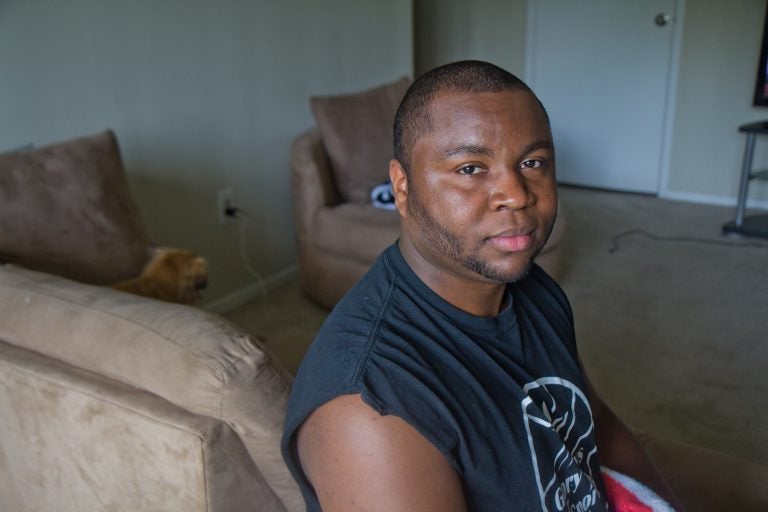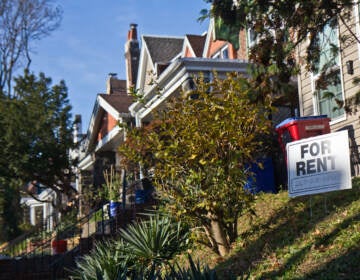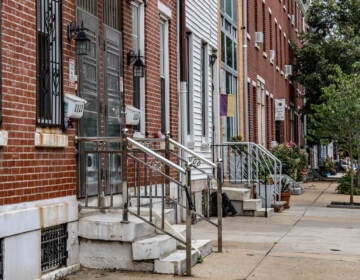To prevent chronic homelessness, Philly nonprofit offers some young adults more than shelter
Permanent supportive housing is one of the most expensive, full-service models out there for helping people experiencing homelessness regain stability.
Listen 6:54
Jerome Maynard at his apartment in Northwest Philadelphia. (Kimberly Paynter/WHYY)
Jerome Maynard’s two-bedroom apartment in Roxborough is a special place — not because of the beige carpeting and white walls, but simply because it’s his.
Roughly a year ago, the 26-year-old was homeless — and had been for the better part of a decade.
“I’m still getting used to it, but it does feel nice,” he said of his home.
Maynard is back on his feet thanks to Project Home’s young adult program, which offers 18- to 23-year-olds permanent supportive housing – one of the most expensive, full-service models out there for helping people experiencing homelessness regain stability.
The relatively high price tag means most communities use it exclusively to help older, chronically homeless adults and families considered most at risk.
In the young adult program – which costs Project Home nearly $500,000 a year, including government subsidies – the Philadelphia nonprofit is taking a different tack, investing in people earlier on with the goal of preventing, and eventually ending, chronic homelessness.
“What my program seeks to do is interrupt cycles of poverty, cycles of trauma, cycles of displacement so that the 22-year-old that we’re serving right now will not be the 32-year-old living in one of our buildings,” said Kate Gormley, who leads the program.
Unlike other housing programs for the homeless, which can max out after a year or two, residents can stay in their subsidized apartments as long as they kick in enough rent – 30 percent of their monthly income with a $400 minimum — through a partnership with the Philadelphia Housing Authority.
The hope is the extra time translates to people moving out when they’re not only ready, but also capable of living on their own — thus, potentially reducing their risk of returning to homelessness.
In addition to housing, the program teaches residents the skills they need to live independently, such as cooking and creating a household budget.
Project Home also provides help for residents who want to get their GED diploma or apply to college, as well as access mental and physical health services.
“It’s not a cookie-cutter program where everyone does the same thing. We really do look at the individual and their needs and what their trajectory could be,” said Gormley.
Since launching in 2014, 63 young adults have participated in the program. Most are still living at one of the three residential sites, while eight have moved out on their own. None of the eight has returned to the streets, according to Project Home. Two other young adults moved out after having children and requiring housing for families.
Suddenly homeless
Before striking out on his own, Maynard spent roughly three years living at Project Home’s JBJ Soul Homes in Fairmount, one of the nonprofit’s three sites offering permanent supportive housing to young adults.
The Ruth Williams House in North Philadelphia and the Francis House of Peace in Chinatown also have beds for this vulnerable population.
When he arrived at JBJ Soul Homes, Maynard had already been homeless for about four years.
When he was 18, just months before he was supposed to start classes at Penn State Abington, Maynard’s aunt kicked him out of her house after he was charged with retail theft – his first and only brush with the law.
Maynard said his friends stole items from a Macy’s in Northeast Philadelphia while he was using the store’s bathroom. He was “guilty by association.”
“As we were leaving the store, the security guard stopped all of us, and, basically, we was all accused of stealing,” he said.
He was eventually found not guilty, but it was the last straw in a strained relationship with his aunt. Not long after he was released from a holding cell, she dropped him off at Covenant House, a shelter for homeless youth in Germantown.
“I lost contact with a lot of people,” he said. “It was pretty much just me.”
Then, after the clock ran out on his time at Covenant House, Maynard landed a spot at the JBJ Soul Homes.
While living there, he worked a few different jobs — at a gym, as a security guard at an apartment complex — until he saved enough money to pay for classes at the Community College of Philadelphia. Not having an expiration date on his stay, as he did at Covenant House, made a big difference, Maynard said. It gave him hope that he could finally leave homelessness behind, and it motivated him.
“It still pushed me to continue to push myself and stay driven because you can fall into a level of complacency. I tried to avoid that as much as possible,” he said.
Staff at JBJ Soul Homes pushed him, too, constantly reminding him that he could change his life.
“Being a competitive person, I didn’t want to let my situation defeat me, so I kept that mindset that, sooner or later, everything was going to become better,” said Maynard, who’s now working toward a communications degree at CCP.
His dream: to become a sports broadcaster.
A rare, but valuable placement
Matthew Morton, who researches youth homelessness at Chapin Hall at the University of Chicago, said experiences like Maynard’s help make the case for having more, high-quality permanent supportive housing programs for young adults.
In the 12 communities Maynard is studying, only about 6 percent of young people who enter their local homeless system are placed into permanent supportive housing.
Because permanent supportive housing is relatively expensive, most communities use the model almost exclusively to help older, chronically homeless adults and families considered most at risk.
“We need to keep these costs in perspective,” Morton said. “When young people with high risk and vulnerability are offered nothing but minimal support or just emergency shelters, we know that they have very little chance of exiting homelessness.”
The same data, said Morton, has revealed the opposite may be true for the few who are placed in good permanent supportive housing programs.
“Our research shows that the vast majority of young people who are placed into supportive housing programs, about nine out of 10, do not re-enter the local homelessness system within a year or more of starting those programs,” said Morton.
It’s just one of the reasons Gormley believes so strongly in Project Home’s young adult program, expected to add at least 30 more permanent supportive housing beds this winter.
“I’m a mom, so I always worry. But, at the end of the day, you know what skills they have and what you’ve offered them and watched them grow over the years,” Gormley said. “So I have a lot of confidence that when folks leave our program that they’re ready to take on independence.”
—
 WHYY is one of 19 news organizations producing Broke in Philly, a collaborative reporting project on solutions to poverty and the city’s push towards economic justice. Follow us at @BrokeInPhilly
WHYY is one of 19 news organizations producing Broke in Philly, a collaborative reporting project on solutions to poverty and the city’s push towards economic justice. Follow us at @BrokeInPhilly
WHYY is your source for fact-based, in-depth journalism and information. As a nonprofit organization, we rely on financial support from readers like you. Please give today.





